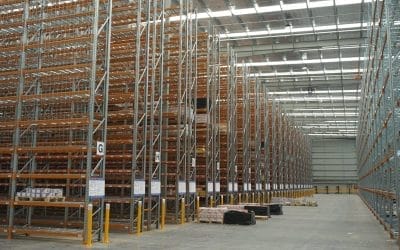Table of contents
One of your top priorities as a warehouse operator is maximising space without compromising safety, and understanding your racking system’s load capacity is critical to achieving this. But how exactly is load capacity calculated, and why is it so important? Let’s explain:
The Basics of Racking Load Capacity
Racking load capacity is essentially the maximum weight your shelving system is engineered to support safely. It’s a figure that doesn’t just come out of thin air but is derived from a comprehensive analysis of several factors, including the material strength, racking design, and the nature of the goods stored. Beyond a mere number, the calculated load capacity is a pledge of safety and operational efficiency.
Step 1: Know Your Materials
The journey to ascertain load capacity starts with understanding the materials constituting your racking system. Different materials exhibit varied strengths and weaknesses. Steel, known for its excellent strength-to-weight ratio, is preferred for constructing heavy-duty racking systems.
Step 2: Design Considerations
The design of your racking system will significantly affect its load capacity. This includes rack dimensions, the number of shelves, and the spacing between them. Each component’s design must align with engineering principles to ensure the structure can bear the intended load.
Step 3: Assessing the Load
Evaluating the load involves more than just weighing the stored items. It’s about understanding how weight distribution affects the racking and the implications of load placement. Uniformly distributed loads are generally more manageable, whereas point loads (where a significant weight is concentrated in a small area) necessitate careful planning as they can diminish the overall load capacity.
Step 4: Safety Factors in load capacity
Safety factors are built into the load capacity calculation for unforeseen circumstances like material fatigue or unexpected loads. This is a critical part of keeping your racking system safe over time.
Step 5: The racking load capacity Calculation
With a grasp of materials, design considerations, load assessment, and safety factors, the load capacity can be calculated using engineering formulas. At Total Racking Systems, we employ Rackman software developed by Dematic engineers. This sophisticated tool uses finite element modelling and second-order analysis to authenticate ColbyRACK designs against the rigorous AS4084-2023 standards. The RackMAN Certification is a testament to the safety and compliance of our racking systems, offering peace of mind regarding their load capacity and structural integrity.
The Role of Professional Assessment
While a basic understanding of load capacity calculation is beneficial, having your racking systems professionally evaluated is crucial. This ensures comprehensive consideration of all factors and compliance with relevant standards, such as AS 4084.1:2023. For more information on safe working loads, read the pallet racking guide by Safework NSW.
Compliance with Confidence
At Total Racking Systems, we eliminate the uncertainties surrounding racking load capacity. We use advanced tools like Rackman software to guarantee that our Colby racking systems meet and exceed the stipulated load capacity requirements. This assurance empowers you to feel confident that your warehouse operations are safe and compliant.
Understanding and accurately calculating your racking system’s load capacity is not merely about optimising storage; it’s about fostering a secure environment for your staff and products. Trust Total Racking Systems to ensure your warehouse’s backbone is robust and secure.
Next Steps
- Get a cost for a racking system
- See more details about pallet racking
- Contact Total Racking Systems for assistance
- Please read our article on choosing the best size, height and load rating for your racking



